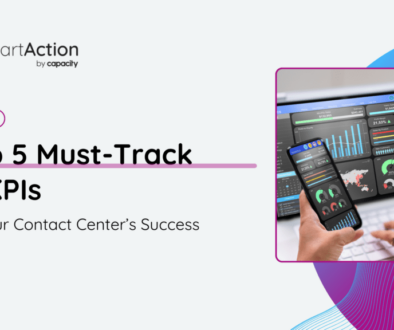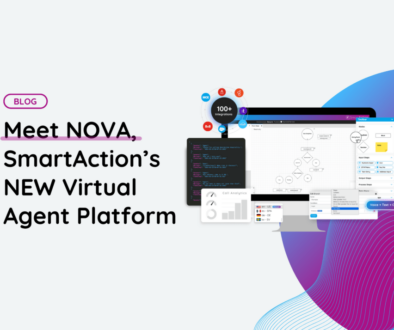What CTOs Should Know Before Implementing Conversational AI in the Contact Center
When used in business, conversational artificial intelligence (AI) supports overall call center operations by providing self-service options, 24/7 availability, and real-time data and analytics – while lowering costs and increasing profits. Plus, it’s infinitely scalable.
For contact center supervisors, the question isn’t whether to implement conversational AI – the benefits are obvious. The question is “how.” Any technology implementation has to align with your overall business goals. Any innovation can have its technical challenges, solutions, and implementation headaches. So it’s wise to consider those in advance.
Conversational AI can be used in any industry for various use cases, including billing and payments, collection, authentication, claims, order management, scheduling, and reservations. The experience for customers and agents is seamless, and the solution can integrate with your current contact center platform, telephony setup, and data systems.
Of course, where and how you start are essential in any technology initiative, so in this article, we’ll provide a roadmap to ensure project success. While you probably have an SOP, conversational AI has unique features that require careful planning to create the optimal conversational design for your customer inquiries.
What Conversational AI Offers
Sales in 2022 increased by 67% when using conversational AI. We’re talking elite customer service solutions here:
- Omnichannel self-service via voice, chat, and SMS
- Integration not only with your contact center but also with your business apps
- Deliver 24/7 personalized customer support
- An average of 66% operational savings
How It Works
Conversational AI works with voice, SMS, and chat. Voice starts with the customer reaching your contact center platform. They can also connect first through SIP (Session Initiation Protocol) or PSTN (Public Switched Telephone Networks). The customer connects with an AI-powered virtual agent that uses a trained and constantly optimized deep neural net, utilizing Natural Language Processing to understand the customer’s problems and intents. It linked via API to internal data sources and current customer input to find a successful solution. Our virtual agents can solve 80% to 90% of customer problems.
If a satisfactory solution can’t be found, the virtual agent forwards the call to a live agent.
With chat, a customer is connected via a chat UI to the virtual agent, which either provides the needed information, solves the issue, or transfers the chat to a live agent.
The Components
Succinctly put, the components of conversational AI include:
- Input generation from humans, either written or spoken
- Input analysis using Natural Language Processing (NLP) to understand intent
- Dialogue management to deliver responses converted into a format humans can understand, either voice or text, using Natural Language Generation (NLG)
- Machine learning, which improves accuracy over time by learning through experience
Considerations Before Implementation
1. Align your conversational AI strategy with overall business goals.
You can’t develop a strategy without defining business goals. This should be easy if your fellow executives properly focus on customer service. Conversational AI is truly transformative and offers a path to long-term success and a competitive advantage. This requires alignment with long-term goals rather than short-term.
Short-term goal: We need to cut call center costs next year.
Long-term goal: We want to increase customer engagement and satisfaction to increase profits, cut costs, and have our customer service agents focus on complex customer issues.
2. Clean up your data
This is where your competitive advantage lies and your key to successful strategy execution. To provide the best customer experience, it must be personalized. This means ensuring you’re working with quality data that’s accurate and consistent.
3. Update other business processes
Conversational AI is far from business as usual, so to drive real value, you’ll have to work with the call center to upgrade processes as well. Agent skillsets must be analyzed, plans made for training, etc.
4. Be certain security isn’t overlooked
SmartAction has been a security-minded company from the very start. We built our data centers with security first in mind. We’ve been PCI DSS Level 1, the highest level of compliance, since 2012. Security should NOT be an afterthought, especially with stronger data regulation rules and insecure new technologies like ChatGPT.
Challenges (and Solutions)
Conversational AI chatbots can handle a massive number of customer queries at a time, 24/7, many without a need for human intervention. Conversational chatbots and IVR can be programmed to handle tasks that include answering frequently asked questions, troubleshooting technical issues, and completing cross-channel transactions.
This makes it particularly important to ensure proper training of your chatbot and IVR so it can handle a wide variety of queries and tasks. While NLP is excellent technology, it needs human language input, which can be challenging. Many dialects, accents, and languages, along with regional slang and jargon, can affect the ability of conversational AI to interpret the raw input. Also, be aware of:
- If input is generated by spoken word, ensure no background noise causes voice distortion.
- There may be unscripted questions that the chatbot or virtual agent doesn’t know how to answer, so it’s essential to consider all scenarios.
- People have unconscious biases that can be programmed into bots and virtual agents. This emphasizes ethical training and deployment. Use a large dataset, perform analysis of the bot or agent’s ability to understand, test in real-life scenarios, and continuously monitor and optimize.
It’s vitally important to keep humans in the loop – only they will be able to detect many of these issues.
Deploying Conversational AI has to be done correctly to complement business strategy and reach customer service interaction objectives.
When trained and implemented correctly, conversational AI can deliver on its promises of seamless, flexible conversations that enhance the customer experience, produce more sales, and increase profitability.
Now you know “how” and “why” to implement conversational AI. You should also know “who”.
When it comes to conversational AI, there’s one clear choice – SmartAction helps implement conversational IVR that’s finely tuned to manage high call volume, leaving agents to offer white glove treatment for more complex issues. This boosts productivity, efficiency, and profits.
SmartAction is the number one rated virtual customer assistant platform, providing conversational AI solutions at a third of the cost of a live agent, with a 30% increase in customer satisfaction scores. We’ve helped over 100 major brands create the very best caller experience. It’s time to crush the competition and reap the rewards of conversational AI. It’s the future, today. Request a demo now.






